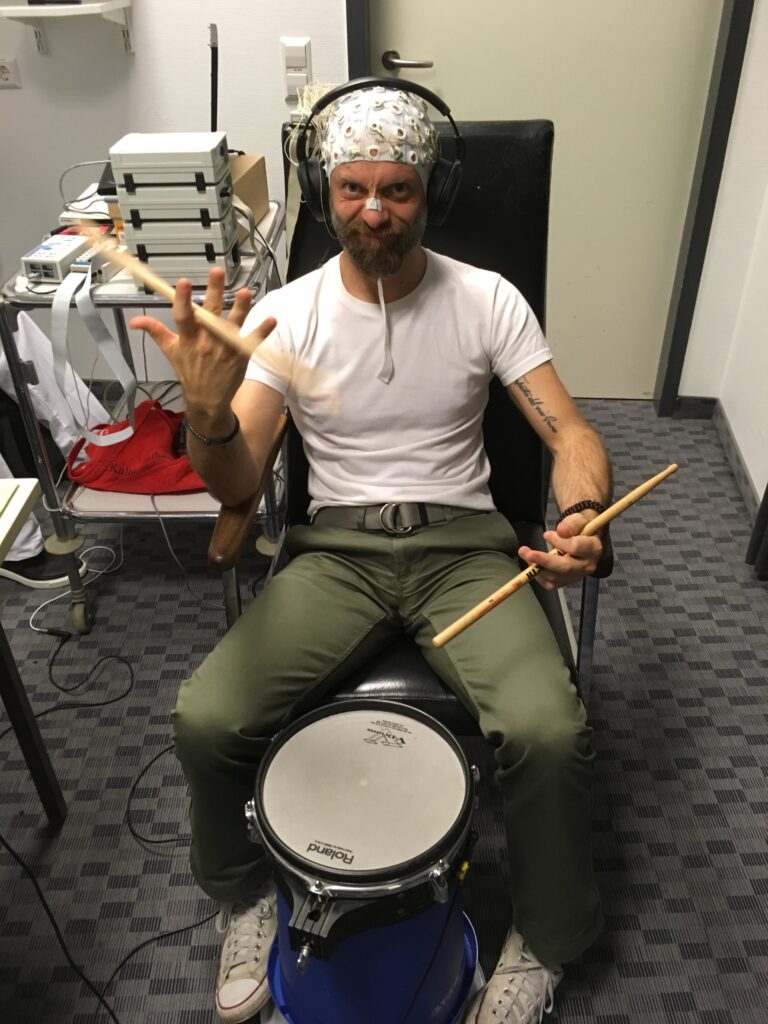


Research + Publications
CTM 2020. Neural Entrainment to Musical Rhythm: A Space Between Perception and Action.
January 2020.
Your Brain on the Dancefloor: Neural Oscillations Support Musical Rhythm Perception >
This issue of the Charité Universiätsmedizin Berlin Neuroscience Newsletter focused on music in the brain. I contributed a quick introduction to the way that your brain translates the sound of James Brown’s music into the movement of dancing feet, as well a brief description of my research with the excellent team at Charité’s Neurophysics Group.
December 2019.
Brains on the Beat: Drumming Precision and Neural Entrainment to Musical Polyrhythm >
How is it that your foot taps in-time to your favorite song, when you’re not even paying attention? To investigate the way the human brain syncs to musical rhythm, myself, as part of the Neurophysics Research Group at Charité Universitätsmedizin Berlin, under the supervision of Drs. Gabriel Curio and Gunnar Waterstraat, conducted this study. We used EEG to record the brain activity of trained musicians and non-musicians as they listened to, and performed complex rhythms. By examining the activity of the brain during this musical task, we gained insight into the mechanism through which humans are able to identify, and align their behavior to, the beat in music. This document was delivered as my Master’s thesis to the Berlin School of Mind and Brain of Humboldt Universität zu Berlin.
October 2019.
The Visceral Experience: Embodiment in Music Cognition >
We typically think of cognition as a process that happens solely within the brain. But a brain without ears connected to it hears no music. The concept of ’embodied cognition’ includes the rest of the body as necessary for thought and perception. This paper explores the role of the body, as well as the brain, in perceiving, understanding and producing music.
September 2019.
The Space Between Your Ears: Auditory Spatial Perception and Virtual Reality >
How does the brain determine whether a sound emanates from behind you, above you, or in front of you? This paper explores how the brain computes the origin location of a sound in space, how virtual reality technology exploits these mechanisms, and how this can be used in research.
March 2019.
Minds Connected in Song: Music Performance as a Setting for EEG Hyperscanning >
‘Hyperscanning’ is a technique in which the electrical activity of two or more people’s brains are recorded simultaneously as those people interact. Applied to musicians as they perform together, this technique is revealing fascinating details of the brain’s activity when we play music together.
March 2019.
The Beat in Our Brains: The Neuroscience of Musical Rhythm >
Whereas melody and pitch are processed in the brain’s auditory cortices, musical rhythm is processed by brain regions associated with bodily motion. This paper offers a broad survey of how the brain handles rhythm in music.
October 2018.
Violent Video Games and Perception of Hostile Intent
Does playing a violent video game make you more likely to interpret another person’s behavior as aggressive once you’ve quit playing for the day? This laboratory study investigated that possibility. The work received the A. Hartman departmental award for excellence. Published as an Honors Thesis for Bachelor of Science degree in Psychology, Tulane University.
May 2000.
